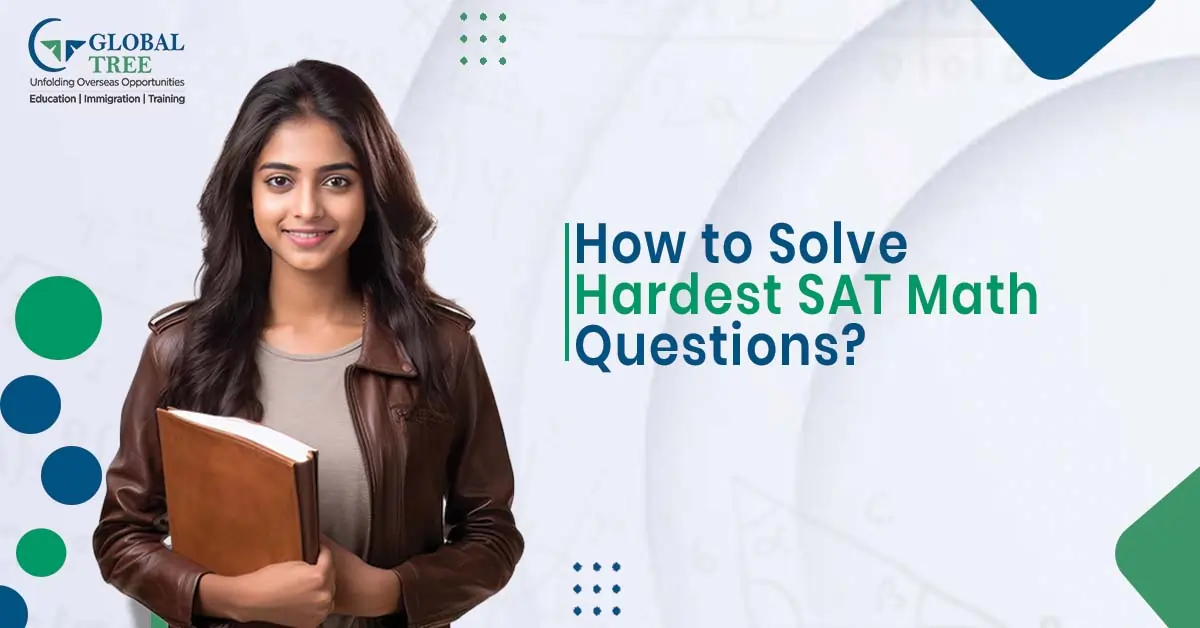How to Solve Hardest SAT Math Questions?

- Introduction
- Understanding the SAT Math Section
- Characteristics of SAT Math Problems
- How to Tackle Hard SAT Math Questions and Answers?
- 1. Understand the Problem Thoroughly
- 2. Break Down Complex Problems
- 3. Use Process of Elimination
- 4. Check for Common Mistakes
- 5. Practice Regularly
- What are the challenging topics in the SAT Math Section?
- 1. Complex Functions and Their Graphs
- 2. Systems of Equations
- 3. Advanced Algebraic Manipulations
- 4. Geometry and Trigonometry Problems
- 5. Data Interpretation and Statistics
- 6. Word Problems Involving Multiple Steps
- 7. Probability and Combinatorics
- Preparing for Hard SAT Math Problems
- Conclusion
Introduction
The SAT, a standardized test widely used for college admissions in the United States, assesses a student’s readiness for college through various sections, including Math. The Math section of the SAT is notorious for its challenging problems, especially the harder ones that test advanced problem-solving skills. For many students, these hard math problems can be intimidating, but with the right strategies and preparation, they can be tackled effectively. This article provides an in-depth exploration of difficult SAT math problems, offering strategies for mastering them and practical examples to guide you through the process.
Understanding the SAT Math Section
The SAT Math section is divided into two parts:
- No Calculator Section: This part consists of 20 questions where you are not allowed to use a calculator. It includes a mix of multiple-choice and grid-in questions.
(Read More: An overview of the SAT Exam Syllabus)
- Calculator Section: This section has 38 questions, including multiple-choice and grid-in questions, where the use of a calculator is permitted.
Both sections test a range of math skills, from basic algebra and geometry to advanced concepts such as trigonometry and complex problem-solving. The harder problems typically appear towards the end of the sections and require a deep understanding of mathematical principles and the ability to apply them in various contexts.
Characteristics of SAT Math Problems
SAT Math Problems often have the following characteristics:
- Complexity: They involve multiple steps and require the integration of different mathematical concepts.
- Trickiness: They may include distractors or misleading information that can confuse students if not carefully analyzed.
- Application of Advanced Concepts: These problems often test higher-level math concepts like quadratic equations, systems of equations, functions, and advanced geometry.
How to Tackle Hard SAT Math Questions and Answers?
Successfully solving hard math problems on the SAT involves more than just knowing formulas and solving equations. Here are some SAT preparation strategies to help you tackle these challenging questions:
1. Understand the Problem Thoroughly
Before jumping into calculations, take the time to carefully read and understand the problem. Look for:
- Keywords and phrases that indicate what the problem is asking.
- Any given information or constraints that are critical for solving the problem.
- What the problem is ultimately asking you to find or prove.
2. Break Down Complex Problems
Complex problems can often be broken down into smaller, more manageable parts. Consider:
- Identifying and solving simpler sub-problems.
- Working backwards from the answer choices if the problem is particularly tricky.
- Drawing diagrams or making tables to visualize the problem.
(Suggested Read: How to calculate your SAT score? Check out!)
3. Use Process of Elimination
For multiple-choice questions, use the process of elimination to narrow down your choices. Discard options that are obviously incorrect to improve your chances of selecting the right answer.
4. Check for Common Mistakes
Many hard math problems on the SAT are designed to trap students into common mistakes. Be cautious of:
- Calculation errors.
- Misinterpreting the question.
- Overlooking key details or conditions.
5. Practice Regularly
Regular practice with challenging math problems is crucial. Use SAT sample papers and high-quality prep materials to expose yourself to various types of hard problems and learn effective solutions.
What are the challenging topics in the SAT Math Section?
Understanding which topics are most challenging can help you focus your preparation efforts. Here are some of the hardest math topics on the SAT, along with explanations of why they are difficult and tips for mastering them.
1. Complex Functions and Their Graphs
Description: Problems involving complex functions often require a deep understanding of function properties, transformations, and graphical interpretations. You may encounter questions that ask you to analyze or manipulate functions, including polynomial, rational, and piecewise functions.
Why It’s Hard: These problems can be challenging because they require a thorough understanding of function behavior, including how changes in the function's equation affect its graph. Students must be able to interpret and manipulate equations and graphs simultaneously.
(Must Know: Is it necessary to take SAT coaching classes? Know Why!
Tips for SAT MMastery:
- Practice graphing different types of functions and understanding their transformations.
- Review key concepts such as domain, range, intercepts, and asymptotes.
- Work on problems that involve combining or comparing functions.
2. Systems of Equations
Description: Systems of equations problems involve solving for multiple variables simultaneously. These can be linear or involve nonlinear equations, such as quadratic systems.
Why It’s Hard: Solving systems of equations can be complex because it requires students to use multiple methods (substitution, elimination) and sometimes combine different types of equations. Additionally, systems with nonlinear equations can introduce additional layers of difficulty.
(Know More: Step-by-step Guide for SAT Test Slot Booking)
Tips to master SAT Math:
- Practice solving both linear and nonlinear systems of equations.
- Familiarize yourself with various methods for solving systems, including substitution, elimination, and graphing.
- Work on problems involving real-world scenarios to understand how systems of equations are applied.
3. Advanced Algebraic Manipulations
Description: This topic involves complex algebraic expressions and equations, including factoring polynomials, solving quadratic equations, and manipulating rational expressions.
Why It’s Hard: Advanced algebraic manipulations require a strong grasp of algebraic rules and the ability to apply them to intricate problems. Students often need to perform multiple steps and combine different algebraic techniques.
Tips for Mastery:
- Focus on mastering polynomial factoring techniques and solving quadratic equations by various methods (factoring, quadratic formula).
- Practice simplifying and combining rational expressions.
- Solve a variety of algebraic problems to strengthen your manipulation skills.
(You may also like: Is it worth attempting SAT exam for Indians?)
4. Geometry and Trigonometry Problems
Description: SAT math problems involving geometry and trigonometry can include topics such as coordinate geometry, properties of shapes, and trigonometric identities and functions.
Why It’s Hard: Geometry and trigonometry problems often require spatial reasoning and the application of multiple geometric properties and trigonometric identities. These problems can be difficult because they require both analytical and spatial thinking.
Tips for Mastery:
- Review fundamental geometric properties and theorems, including those related to angles, triangles, circles, and polygons.
- Study trigonometric identities, functions, and their applications.
- Practice solving questions related to quadrilaterals, geometry and trigonometry in various contexts to improve your spatial reasoning and problem-solving skills.
5. Data Interpretation and Statistics
Description: Problems related to data interpretation involve analyzing and interpreting various forms of data, such as charts, tables, and graphs. This topic also includes statistical concepts like mean, median, mode, and standard deviation.
Why It’s Hard: Data interpretation problems require students to accurately interpret and analyze data presented in different formats. Additionally, statistical concepts can be complex and require careful application of formulas and principles.
Tips for Mastery:
- Practice interpreting data from charts, tables, and graphs.
- Review statistical concepts and how to calculate measures of central tendency and dispersion.
- Work on problems that involve comparing and analyzing data sets to strengthen your data interpretation skills.
6. Word Problems Involving Multiple Steps
Description: Word problems on the SAT require translating verbal descriptions into mathematical equations and solving them. These problems often involve multiple steps and can integrate various mathematical concepts.
Why It’s Hard: Word problems are challenging because they require students to decipher complex language and convert it into a solvable mathematical format. The need to perform multiple operations likE BODMAS in SAT and keep track of various details can make these problems particularly difficult.
Tips for Mastery:
- Practice translating word problems into mathematical equations.
- Break down problems into smaller, manageable parts and solve step-by-step.
- Familiarize yourself with common problem types and strategies for solving word problems.
7. Probability and Combinatorics
Description: Probability and combinatorics problems involve calculating the likelihood of events and determining the number of possible combinations or arrangements of objects.
Why It’s Hard: These problems can be difficult because they require a strong understanding of probability rules and combinatorial principles. They often involve complex calculations and logical reasoning.
Tips for Mastery:
- Review probability concepts, including basic probability rules, permutations, and combinations.
- Practice solving problems that involve calculating probabilities and counting arrangements.
- Work on problems that integrate probability and combinatorics with other mathematical concepts.
(Suggested Read: Key Things to Know Before Taking the SAT in India)
Preparing for Hard SAT Math Problems
To excel in the Math section, consider the following SAT preparation tips:
- Use Quality Study Materials: Invest in high-quality SAT prep books and online resources that offer challenging practice problems and detailed explanations.
- Take Practice Tests: Regularly take full-length practice tests under timed conditions to build endurance and familiarize yourself with the test format.
- Review Mistakes: Analyze your mistakes on practice tests to understand where you went wrong and how to improve.
- Seek Help: If you're struggling with specific concepts, consider working with a tutor or joining a study group for additional support.
Conclusion
SAT Math Problems can be challenging, but with the right strategies and preparation, you can tackle them effectively. Understanding the nature of these problems, applying effective problem-solving techniques, and practicing regularly are key to mastering the SAT Math section. By approaching difficult problems with confidence and a strategic mindset, you can enhance your performance and achieve your desired score on the SAT.


